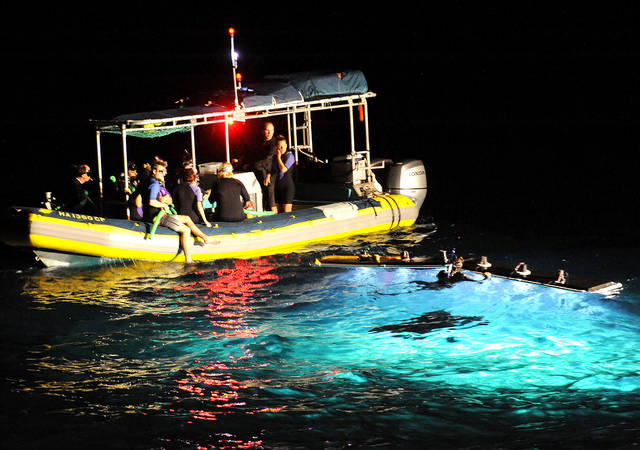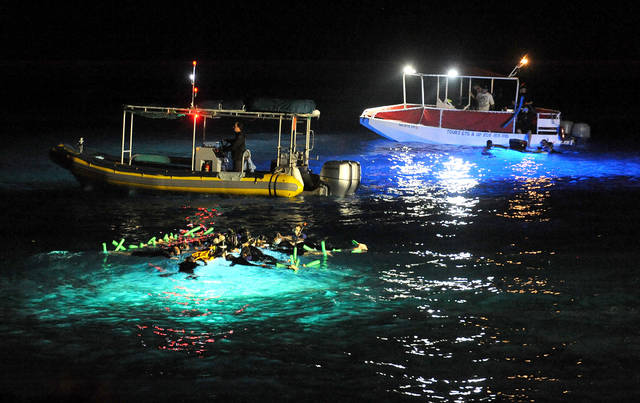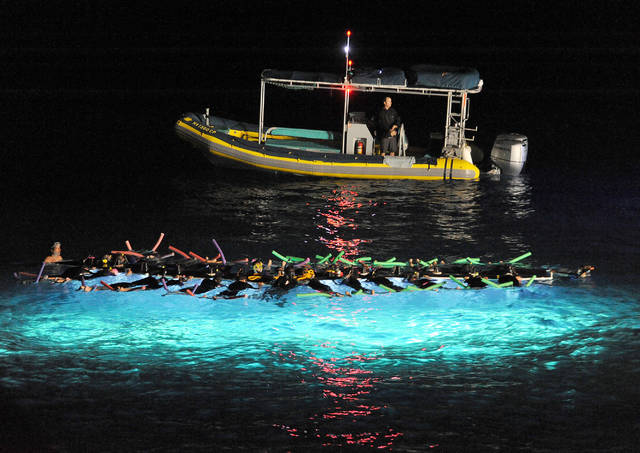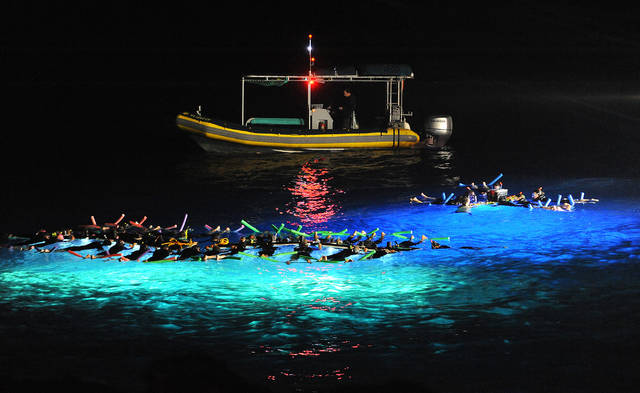KAILUA-KONA — Following years of discussion and deliberation, the Department of Land and Natural Resources has formulated a list of draft rules regarding proposed regulations and changes to manta ray viewing sites.
The department’s Division of Boating and Ocean Recreation crafted the rules with Hawaii Island specifically in mind, as manta ray excursions represent a multi-million dollar industry in West Hawaii that has been essentially unregulated throughout its existence.
DOBOR distributed the draft rules to Big Island legislators and commercial manta ray tour operators in advance of the document’s scheduled release on March 26 when the proposed regulations will be available for general review prior to public hearings yet to be announced.
“The project on manta ray rules began in 2014 with informal stakeholder engagement and is the first step in the process to implement administrative rules,” DLNR spokesperson Deborah Ward wrote in an email to West Hawaii Today. “We estimate the remainder of the process, including formal rule making, will take about one to two years before actual rule changes go into effect.”
Ward added that due to the lack of rules to govern the practice, no permits specifically for manta ray tours have ever been issued. Instead, anyone who currently holds a general commercial use permit is eligible to operate a tour.
Keller Laros, founder of the Manta Pacific Research Foundation and owner of Laros Diving Inc., which owns a 50 percent share of Jack’s Diving Locker, said improving safety for tourists and manta rays while maintaining a sustainable industry begins with the permitting process.
“There are no barriers to the industry,” Laros said. “There’s a company in town that hired a homeless guy to be a snorkel guide. Maybe he’s trained, maybe he’s not … but they’ll hire anyone just because they can.”
Permitting regulations proposed in the draft rules would, among other stipulations, require documentation of manta ray viewing site usage and proof that the applicant has an established history of operating tours.
Regulations as written would also mandate one permit per vessel and set in place punitive actions for repeat rules violators that may result in suspension or revocation of manta ray tour permits.
Ward said DOBOR believes the “ideal” number of permits is 24 at each of the two manta viewing sites, Keauhou Bay and Makako Bay near Keahole Point. Each site will support 12 commercial moorings and allow for manta ray viewing between the hours of 4 p.m.-4 a.m.
Rules would stipulate one tour boat per mooring and prohibit daisy-chaining or rafting — the tethering of several boats together. Laros said he’s seen between 20-30 boats at a viewing site at one time.
The department would also implement time limits for commercial operators and provide a 13th mooring at each site reserved for non-commercial use.
Ward said the planned permit amount will stretch as high as 30 for each site so as to allow all eligible operators an opportunity to obtain a permit. DOBOR has identified 51 eligible manta tour operators to date.
The reduction to 24 operators per site would come through a process of “reduction by attrition,” she explained.
“The intended way to address permit reduction is for operators to leave the business or for repeat violators to lose their permits either through revocation or denying renewal of their permit,” Ward said. “One year after the effective date of the rules, DOBOR would not issue any additional permits unless the number of permits for a site is less than 24, on a site-by-site basis.”
Laros, who has reviewed the rules, called them a good start, citing common misbehavior exacerbated by overcrowding.
He said that includes operators driving too fast throughout viewing sites without employing a lookout, tour boats attaching subsurface lights to individual vessels to draw mantas to their areas and sometimes dangerously unfavorable ratios of guides to snorkelers.
DOBOR’s proposed regulations address all of these issues, as well as others brought up by legislators and tour operators who’ve added input throughout the process.
Laros said there have been human fatalities in manta ray viewing zones, although they’ve typically been related to pre-existing conditions. However, the ratio of guides to swimmers can make everyone less safe when one or two guides without medical training are focused on an emergency while several dozen other tourists are ignored.
Rep. Nicole Lowen (D-North Kona) introduced House Bill 2265 this session, which would have required a mandatory ratio of one tour guide or instructor per eight customers and mandated each guide be a certified lifeguard or dive master.
The measure passed one committee in the state House of Representatives before dying in early February.
Public hearings and redrafts to DOBOR’s proposal are coming. Laros, who was largely complimentary of the regulations, noted one issue he’d like to see addressed.
“They’re making rules to apply to specific sites but what they really need to do is make rules that apply to the industry,” Laros said. “There are places up north in Kohala where they get manta rays as well, so you can have the best rules in the world down here and have people go up and just be complete asses at other locations.”















What about the $3000 a month to use the ocean like surfers have to pay?
Agreed, these tour operators should have to bid on permits like surf schools at Kahaluu. Hope the enforcement is better than at Kahaluu.
If we lucky, DOCARE soups will assign guys to work the night shift. However, DOCARE could initiate reports to forward to the Prosecutors office if many of the citizens that complain via cell phone use their cell phone to take images/videos of the activities AND be willing to TESTIFY. Don’t hold your breath.
Why in the world would it take two years? It wiil be the wild west out there now they know that rules will be coming. Total state inneffectiveness.